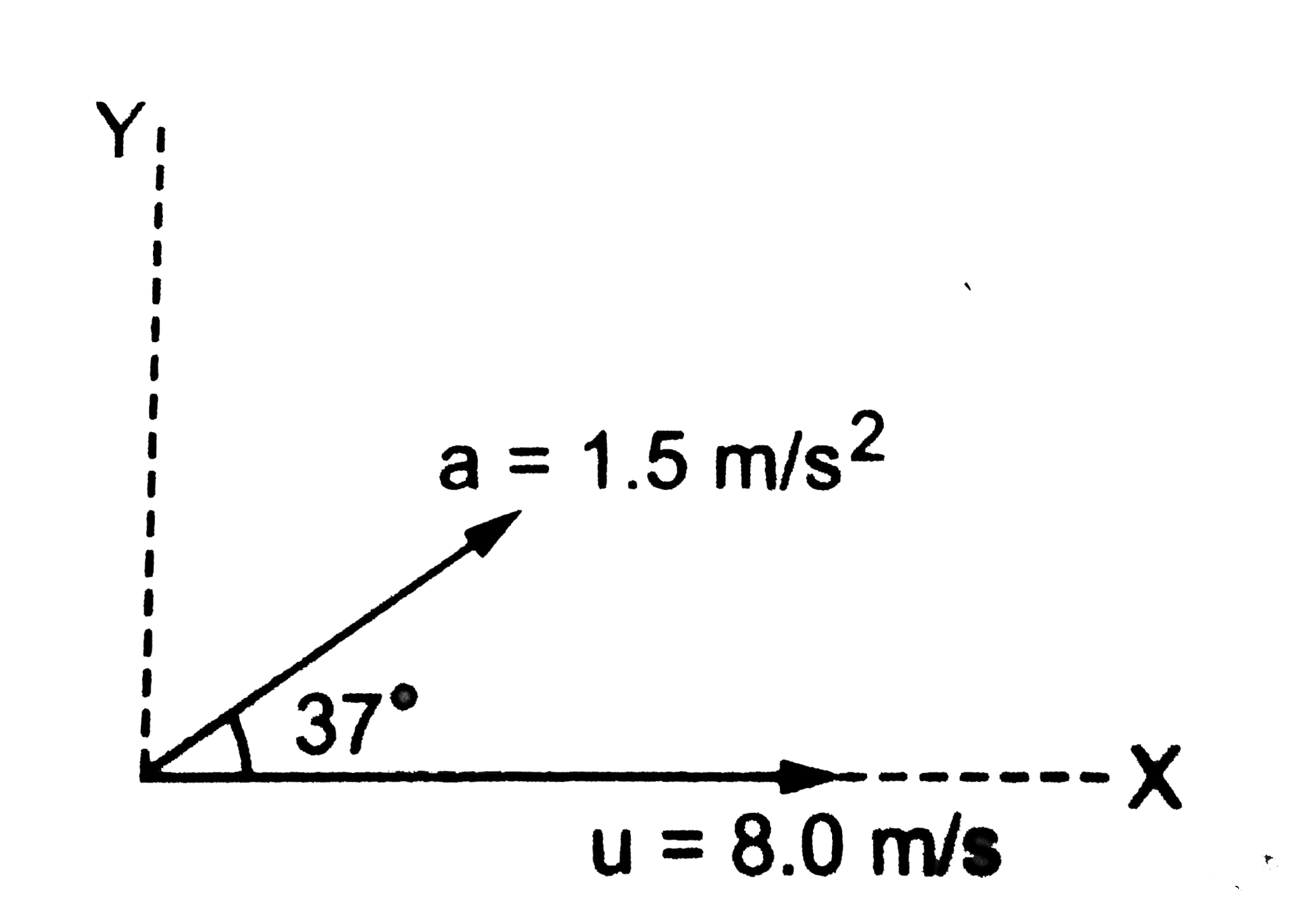A particle moves in the x−y plane with constant acceleration of 4m.s−2 in the direction making an angle of 60∘ with the x-axis. Initially, the particle is at the origin and its velocity is 5m.s−1 along the x-axis. Find the velocity and the position of the particle at t=5s.Solution in Bengali
According to the question if the initial velocity of the particl e along OA is u then (given ux=5 m/s)
u = uxcos60∘=5×12=52m/s
The velocity of the particle at t = 5s,
v = u +at =52+4×5= 22.5 m/s

At that time the distance travelled by the particle along OA,
s=ut+12at2=52×5+12×4×52
=252+50=1252 m
If the coordinate of the particle is (x,y) at that time then
x = 1252cos60∘=1252×12=1254
and y = 1252sin60∘=1252×√32=,125√34
∴ Position of the particle at t = 5 s is (1254,125√34).
Topper's Solved these Questions
- ONE - DIMENSIONAL MOTION Book:CHHAYA PUBLICATIONChapter:ONE - DIMENSIONAL MOTION Exercise:EXAMINATION ARCHIVE with solutions (WBJEE )
Explore 4 Videos
- ONE - DIMENSIONAL MOTION Book:CHHAYA PUBLICATIONChapter:ONE - DIMENSIONAL MOTION Exercise:EXAMINATION ARCHIVE with solutions (JEE Main )
Explore 4 Videos
- ONE - DIMENSIONAL MOTION Book:CHHAYA PUBLICATIONChapter:ONE - DIMENSIONAL MOTION Exercise:ENTRANCE CORNER ( Integer answer type )
Explore 5 Videos
- NEWTONIAN GRAVITATION AND PLANETARY MOTIONBook:CHHAYA PUBLICATIONChapter:NEWTONIAN GRAVITATION AND PLANETARY MOTIONExercise:CBSE SCANNER
Explore 19 Videos
- QUESTION PAPERS OF NEET -2017Book:CHHAYA PUBLICATIONChapter:QUESTION PAPERS OF NEET -2017Exercise:QUESTION
Explore 32 Videos
Similar Questions
A particle moves with constant acceleration along a straight line starting from rest. The percentage increase in its displacement during the 4th second compared to that in the 3rd second is
View SolutionFrom a tower of height H, a particle is thrown verticially upward with a speed u. The time taken by the particle to hit the ground is n times that taken by it to reach the highest point of its path. The relation between H, u and n is
View SolutionThe displacement x of a particle moving in one dimension under the action of a constant force is related to time t by the equation t = √x+3 where x is in meters and t is in seconds. Finds the displacement (in metres ) of the particle when its velocity is zero.
View SolutionWhat is the reason for absence of atmosphere in some planets?
View SolutionA molecule of a substance has permanent dipole moment p . A mole of this substance is polarised by applying a storg electrostatic field E . The direction of the field is suddenly changed of 60∘ . If N is the avogadro's number the amount of work done by the field is
View SolutionA particle movesin the X-Y plane with a constasnt acceleration of 1.5ms2 in the direction making an angle of 370 with the X-axis.At t=0 the particle is at the orign and its velocity is 8.0 m/s along the X-axis. Find the velocity and the position of the particle at t=4.0 s.

View SolutionAt t=0, the particle is at the origin and its velocity is 10m/s at an angle 37∘ with the x-axis. The particle moves in x−y plane with a constant acceleration of 1m/s2 along the y-axis. Find the magnitude and direction of the velocity after 2s.
View SolutionA particle is moving along a straight line along x-zxis with an initial velocity of 2m/s towards positive x-axis. A constant acceleration of 0.5m/s2 towards negative x-axis starts acting on particle at t=0. Find velocity (in m/s) of particle at t=2s.
View SolutionA particle moves along x-axis with acceleration a=6(t-1) where t is in second. If the particle is initially at the origin and it moves along positive x-axis with v_(0)=2m//s , find the nature of motion of the particle.
View SolutionA particle moves in the plane x y with constant acceleration a directed along the negative y-axis. The equation of motion of the particle has the form y = k_(1)x-k_(2)x^(2) , where k_(1) and k_(2) are positive constants. Find the velocity of the particle at the origin of coordinates.
View SolutionTwo particles start moving from point A along a straight line AB at the same time in the same direction. One particle moves with a uniform velocity of 12 "m.s"^(-1) and the other with an acceleration of 2 "m.s"^(-2) and an initial velocity of 5 "m.s"^(-1) . After how much time will the two particles meet ?
View SolutionA particle moves in the x-y palne with a constant acceleration of 1.5m//s^(2) in the direction making an angle of 37^(@) with the x-axis. At t=0 the particle is the origin and its velocity is 8.0m/s along the x- aixs . Find the velocity and the position of the particle at t = 4.0s.
View SolutionA particle movesin the X-Y plane with a constasnt acceleration of 1.5ms2 in the direction making an angle of 370 with the X-axis.At t=0 the particle is at the orign and its velocity is 8.0 m/s along the X-axis. Find the velocity and the position of the particle at t=4.0 s.

View SolutionA particle moves along the X-axis as x=u(t-2)+a(t-2)^(2) a) the initial velocity of the particle is u b) the acceleration of the particle is 2a c) at t=2s particle is at the origin
View SolutionA particle moves along the X-axis as x=u(t−2)+a(t−2)2
a) the initial velocity of the particle is u
b) the acceleration of the particle is 2a
c) at t=2s particle is at the origin
View Solution

